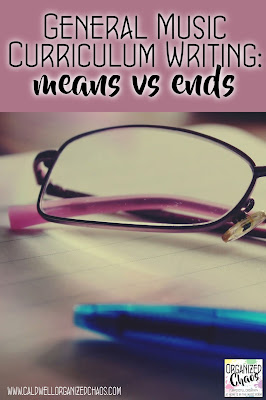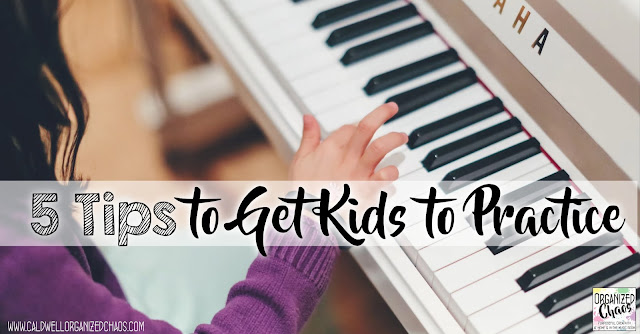I love taking a little time each month to reflect on some of the highlights from my home and teaching life. Plus I get to share some really awesome articles from other music education blogs and websites, which I always highly recommend taking a few minutes to read! Here are my favorites from the month of May, as told by photos I shared on Instagram this past month- follow me here to see what I'm up to in the months ahead!
Concert Hack
I've actually been doing this my entire teaching career but I believe this is the first time I've shared this little "music teacher hack" for concert season and it's definitely one of my favorite tricks! I wear the students' concert dress (which for me is black bottoms and white tops) the day before the concert to serve as a visual reminder. That brief moment of panic that many students experience when they see me and think the concert is that day helps cement the memory in their brain, making them more likely to remember their clothes for the performance as well 😉
Signs of Spring
The weather in my part of the world has been... far from normal this year. Lots of snow days going all the way into April, a tornado in May, lingering cold temperatures interspersed with one or two days of blazing hot.... So I have treasured the colorful blossoms in my garden and around town even more this year!
Themed To-Do Lists
This is the time of year when I start making and referencing master to-do lists- they are my secret weapon for saving my sanity. Normally I just have a running to-do list that I keep in my planner, but when I have a big, complicated task that I need to work on over time I make a separate list just for that task/event. This time of year, of course, I have multiple complicated tasks that I need to work on simultaneously, so I rely heavily on these innocent-looking post-it notes! I pull them out of my planner and stick them on my seating chart at school, move them from week to week in my planner to reference for my lesson planning and calendar, and take them with me to meetings when I'm working with coworkers on logistics. The rainbow one in the picture above is for a school-wide informance I have coming up- it's a running list of the equipment and instruments I need for each grade level's performance so I can pull out the correct number of each item to practice in class, make sure I have enough for when the whole school comes together, and have a "packing list" for when I'm setting up the day of the show! You can't see them, but underneath that long, rainbow sticky note are two more square sticky notes, which have running to-do lists for other events I'm planning.
I wrote an entire blog post on themed to-do lists here if you want to learn more about how I use these!
Music Education Articles
I share articles from my favorite music education writers each Friday on my Facebook page- follow me there if you want to see them as I share them, and if you are a writer with a music education post to share, you can fill out the form here to submit it for consideration- I love learning about new sites and articles this way! Click on each picture below to read each of these awesome posts:
I hope you are all looking forward to a month ahead! For those of you on (or soon to be on) summer vacation: enjoy the change of pace! I hope you can take some time to process and reflect on your school year so you can be ready for the next one. For those of you like me still in the thick of teaching: we can enjoy ourselves too! I hope you find ways to enjoy the remaining time you have with your students!
Want to stay in touch and get more ideas sent straight to your inbox? Click here to sign up for the Organized Chaos newsletter.
Concert Hack
I've actually been doing this my entire teaching career but I believe this is the first time I've shared this little "music teacher hack" for concert season and it's definitely one of my favorite tricks! I wear the students' concert dress (which for me is black bottoms and white tops) the day before the concert to serve as a visual reminder. That brief moment of panic that many students experience when they see me and think the concert is that day helps cement the memory in their brain, making them more likely to remember their clothes for the performance as well 😉
Signs of Spring
The weather in my part of the world has been... far from normal this year. Lots of snow days going all the way into April, a tornado in May, lingering cold temperatures interspersed with one or two days of blazing hot.... So I have treasured the colorful blossoms in my garden and around town even more this year!
Themed To-Do Lists
This is the time of year when I start making and referencing master to-do lists- they are my secret weapon for saving my sanity. Normally I just have a running to-do list that I keep in my planner, but when I have a big, complicated task that I need to work on over time I make a separate list just for that task/event. This time of year, of course, I have multiple complicated tasks that I need to work on simultaneously, so I rely heavily on these innocent-looking post-it notes! I pull them out of my planner and stick them on my seating chart at school, move them from week to week in my planner to reference for my lesson planning and calendar, and take them with me to meetings when I'm working with coworkers on logistics. The rainbow one in the picture above is for a school-wide informance I have coming up- it's a running list of the equipment and instruments I need for each grade level's performance so I can pull out the correct number of each item to practice in class, make sure I have enough for when the whole school comes together, and have a "packing list" for when I'm setting up the day of the show! You can't see them, but underneath that long, rainbow sticky note are two more square sticky notes, which have running to-do lists for other events I'm planning.
I wrote an entire blog post on themed to-do lists here if you want to learn more about how I use these!
Music Education Articles
I share articles from my favorite music education writers each Friday on my Facebook page- follow me there if you want to see them as I share them, and if you are a writer with a music education post to share, you can fill out the form here to submit it for consideration- I love learning about new sites and articles this way! Click on each picture below to read each of these awesome posts:
"Teaching Whiteness in Music Class"
I hope you are all looking forward to a month ahead! For those of you on (or soon to be on) summer vacation: enjoy the change of pace! I hope you can take some time to process and reflect on your school year so you can be ready for the next one. For those of you like me still in the thick of teaching: we can enjoy ourselves too! I hope you find ways to enjoy the remaining time you have with your students!
Want to stay in touch and get more ideas sent straight to your inbox? Click here to sign up for the Organized Chaos newsletter.

































